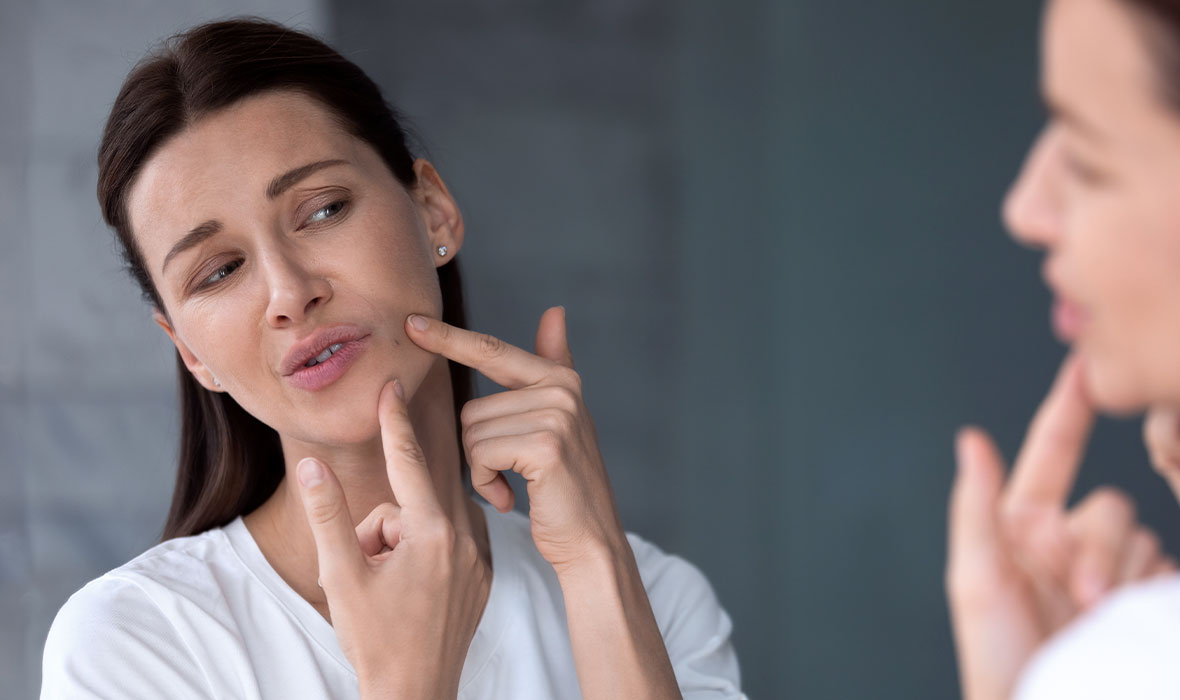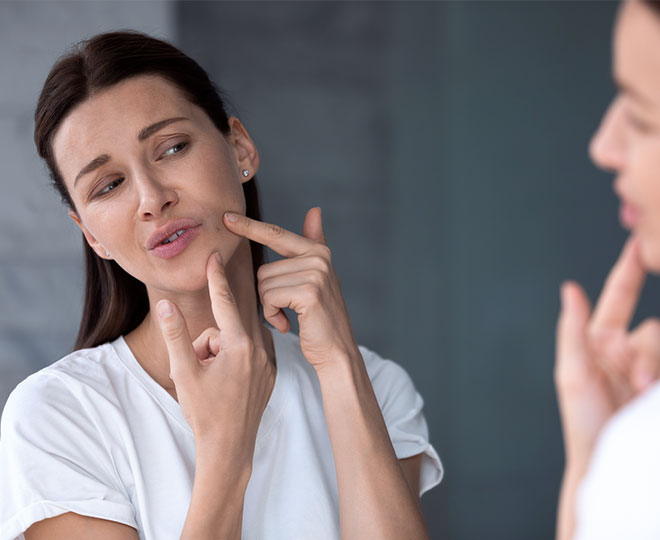If you’ve heard the term "hormonal acne", you’re probably wondering, "What is hormonal acne?", "What causes hormonal acne?", "Is my acne hormonal? and "How do I get rid of hormonal acne?" Good news: Your questions are about to be answered.
Plus, you’ll learn how to stop hormonal acne, what menopause acne is, and some of the best treatments for hormonal acne — so you can gain the knowledge that helps you get your breakouts under control.
So why is the term "hormonal acne" not sounding familiar? It turns out that hormonal acne is so common that health providers usually just refer to it as, well, acne. So if this is the first time you’ve heard of it, that’s okay.
What is hormonal acne?
To put it in an easy-to-remember way, hormonal acne are breakouts that are tied to the fluctuations in the hormones your body produces — specifically when your body produces more testosterone than it needs. Another term for hormonal acne is acne vulgaris. Generally speaking, acne is defined as clogged and/or inflamed pores, which you might call blackheads, whiteheads, pastules, and pustules… or just pimples!
Did you know that hormonal acne affects about 85% of teens? Yep, it seems to be the unwanted gift from puberty. It’s not just common – it’s often predictable, usually arriving at the same time as a woman’s monthly period cycle. But it affects women and men, especially during puberty when androgen hormones like testosterone start to get produced in high levels.
But how do these hormones trigger acne? They enlarge your body’s sebaceous glands, which makes them produce extra sebum (aka oil) to lubricate your skin. When you have more sebum and less shedding of dead skin cells, your pores can become clogged with a mixture of the two. Bacteria makes its way in, and then you’ve got acne.
But just because your hormones are fluctuating doesn’t mean you are going to get acne — everyone has varied sensitivity to these hormones. And, not everyone produces the same amount of these hormones.
For example, women have less of the male hormone testosterone circulating. If you’re wondering why women need male hormones like testosterone, it’s because they are essential for a multitude of functions such as strength and energy. Does it seem like your breakouts are worse than those of your peers, especially during your period? It’s most likely because you have higher levels of testosterone during this time. And of course, men need the androgen hormone testosterone for male development among other things.
What causes hormonal acne?
So now you know that hormones play a significant role in causing hormonal acne —hence the name. But, there’s a bit more to it than that. Hormones are actually only one of four major factors responsible for acne formation.
- The rise of the hormone testosterone during puberty: At the base of the hair follicles, sebum production increases causing oily skin and contributing to clogged pores
- Blocked hair follicles (aka clogged pores): there’s an overproduction of skin cells that get trapped with the extra sebum
- A bacterial infection: this can cause comedones to worsen
- Inflammation: this can happen when the immune system comes to the rescue
Plus, puberty isn’t the only time you can have fluctuating hormones. It can happen during menstruation, menopause, pregnancy and post-partum, or even polycystic ovarian syndrome. All of these changes in your body can increase sebum production, clogged skin cells in hair follicles, skin inflammation, and the production of acne-causing bacteria.
But don’t get too mad at testosterone for your acne — it’s not the only hormone responsible for that pimple on your chin. Cortisol, which releases from the adrenal glands during stressful times, often triggers acne in women, which is why women in their 20s-50s still get hormonal acne in the form of stress breakouts.
Hormonal acne symptoms to look out for
So how do you know what hormonal acne looks like? It appears as whiteheads, blackheads, painful cysts deep under the skin that don’t come to a head, or smaller pimples that are inflamed and look like red bumps, or come to a head with white pus in them on the surface.
Hormonal acne can show up in your T-zone (the shape of a capital T on your face — your forehead, chin, and nose. But it usually forms on the lower part of the face, around your jawline, lips, chin, and lower cheek area.
Hormonal acne comes in all forms: You may have mild hormonal acne with a few whiteheads and blackheads, moderate acne with inflamed, red pimples, or severe deep acne nodules beneath the skin or cystic lesions filled with puss.
But not to worry, you’ll soon learn how to treat your hormonal acne so you’ll be in the clear before you know it!
How to help hormonal acne
Luckily, with the right lifestyle changes and effective skincare products you can significantly improve mild to moderate hormonal-based acne.
There are some hygiene and lifestyle enhancements you can make to keep acne from getting out of hand.
- Use water-based makeup instead of oil-based makeup
- Never pick your pimples because this can allow bacteria into the pore, making matters worse
- Wash your face twice each day unless you need to add a third wash or shower after sweating profusely
- Drink black or green tea as studies have demonstrated their beneficial properties
- Eat plant-based foods rich with antioxidants that can help lower skin irritation
What about diet? Recent research has shown that whether or not you get acne may be affected by what you eat — or don’t eat. Milk products, especially skim milk, have been linked to acne formation as well. Plus, evidence shows that foods that have a high glycemic index (think white bread, white potatoes, sugary drinks and other high-carb and high-sugar foods) can increase your blood sugar levels, which can then impact your hormone levels. And you know now that your hormone fluctuations can trigger acne. For some people, what they eat does affect their acne and for others it doesn’t at all. So if you’re not sure, you can try taking precautions not to overdo it on the sugar and carbs to see if you notice a difference, but there’s no guarantee.
And a powerful tool for controlling your hormonal acne? Retinoids! Retinoids, like Adapalene, help your skin cells turn over faster — so your skin can shed the dead cells that clog pores before sebum has a chance to sneak in and build up in your pores.
The United States Food and Drug Administration (FDA) has only approved the retinoid Adapalene for over-the-counter acne treatment. Adapalene helps:
- address redness and inflammation from stubborn acne
- restore a more even skin tone, texture, and radiance by clearing breakouts
- treat and prevent clogged pores like blackheads and whiteheads
Must-have products for helping to treat hormonal acne
The good news is, Adapalene, found in our ProactivMD system is a great way to help treat hormonal acne. Adapalene is the star player in the ProactivMD trio — it helps clear and prevent stubborn breakouts while restoring healthy-looking skin.
Adapalene is ideal for treating stubborn hormonal breakouts — and the redness and inflammation that often appear alongside them. It’s our prescription-strength formula that works on a cellular level to clear skin, which helps restore even tone and texture. It’s tough on breakouts but gentle on your skin, thanks to our soothing cleanser and gentle, hydrating moisturizer.
The bottom line
We can’t always control our hormones or stress levels, but we can proactively work on our hygiene, what we eat and what we put on our skin to treat hormonal acne.






